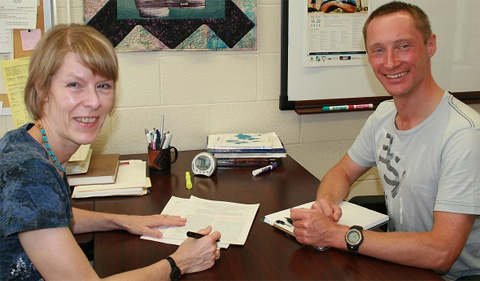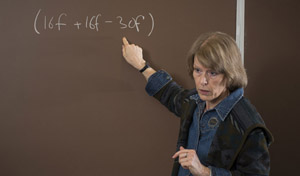
Charlotte Elster, left, and Vasily Eremenko, right, collaborate on nuclear physics research in the Department of Physics and Astronomy. Photo by Jean Andrews.
Vasily Eremenko is a postdoctoral fellow in the Department of Physics and Astronomy‘s Institute of Nuclear and Particle Physics. He works with Professor Charlotte Elster.
In honor of National Postdoc Appreciation Week Sept. 15-19, the Office of Research Communications is spotlighting Ohio University postdoctoral fellows across campus.
Eremenko recently participated in a Q&A for the Office of Research Communications.
Please tell us about your research, scholarship or creative work.
I am working with Professor Charlotte Elster to improve our understanding of nuclear reactions. In particular, we are working on deuteron stripping reactions [(d, p)-reactions] with exotic nuclei. These are reactions in which a beam of exotic neutron-rich nuclei hits a deuteron (the lightest nucleus made of a proton and neutron), breaks it and thus absorbs the neutron to become even more neutron rich.
These reactions allow us to understand the detailed structure of these rare isotopes, which do not naturally occur since they are so short-lived. However, they are made in hot stellar environments, like a supernova explosion, and are part of the nuclear chain reactions that eventually lead to the stable elements found, e.g., on Earth. In the laboratory, e.g. at the National Superconducting Cyclotron Laboratory at Michigan State University, specific reactions are measured, and my work relates to developing a theoretical framework to compute measured reaction cross-sections, so that information about an exotic nucleus can be correctly extracted.
I am part of the U.S. Department of Energy-funded Topical Collaboration on the “Theory of Reactions for Unstable Isotopes” (TORUS). The goal is to develop new methods that will advance the theory of nuclear reactions for unstable (rare) isotopes. This collaboration involves researchers in the Department of Physics and Astronomy at Ohio University (me, my adviser and graduate student Linda Hlophe), Michigan State University, Oak Ridge and Lawrence Livermore National Laboratories and Texas A&M University.
How long have you been a postdoctoral fellow, and what are your primary responsibilities in your lab, program or team?
This is my second year as a postdoc with Professor Charlotte Elster. Prior to coming here, I spent a year at Texas A&M University after graduation from Moscow State University. My primary responsibilities are laid out in the research agenda of the TORUS Collaboration.
My particular role there concentrates on the implementation of a newly proposed sophisticated reaction theory model for (d, p), which is designed to compute the (d, p)-reaction involving heavy exotic nuclei, e.g. Tin isotopes, which is not possible at the moment. This means that I work on the theoretical formulation of the theory to cast it in such a form that can be implemented on a large computer like the Ohio Supercomputing Center or the National Energy Research Scientific Computing Center.
I participate in meetings of the TORUS Collaboration, the INPP Nuclear Theory Group meetings, and special seminars in the Department of Physics and Astronomy. Of course, I work with graduate students, especially Linda Hlophe, a member of the TORUS team. I also assist with solving other problems, especially those related to computational issues.
How does your postdoc position benefit you and how will it help you in your career?
I get research experience, improve my skills in solving the complicated multifactor problems, present the results at conferences, write papers, and also work on a number of different projects all at the same time. My postdoc has already helped to make me a better nuclear physicist and will enhance my career by providing the opportunity to work with excellent colleagues and solve pressing problems in our field of study. Of course, I’m developing new friendships and gaining a good deal of cultural understanding, both of which enrich my time here.
How do university research programs benefit from postdocs?
Postdocs are closing the gap between the qualification levels of professors and students. The postdocs are able to give undivided and significant attention to solving complex problems in science, a luxury many professors may not have due to teaching and administrative duties.
At the same time, a postdoc can learn a great deal from the professor’s own research inquiry. This synergy significantly improves the ability of a university to do the high-profile research the world needs and to provide an excellent education for all students.



















Comments